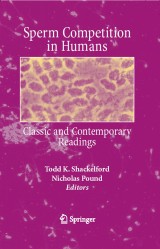Details

Sperm Competition in Humans
Classic and Contemporary Readings|
149,79 € |
|
| Verlag: | Springer |
| Format: | |
| Veröffentl.: | 22.11.2006 |
| ISBN/EAN: | 9780387280394 |
| Sprache: | englisch |
| Anzahl Seiten: | 286 |
Dieses eBook enthält ein Wasserzeichen.
Beschreibungen
In species with internal fertilization, sperm competition occurs when the sperm of two or more males simultaneously occupy the reproductive tract of a female and compete to fertilize an egg (Parker, 1970). A large body of empirical research has demonstrated that, as predicted by sperm competition theory, males and females in many species possess anatomical, behavioral, and physiological adaptations that have evolved to deal with the adaptive challenges associated with sperm competition. Moreover, in recent years, evolutionary biologists and psychologists have begun to examine the extent to which sperm competition may have been an important selective pressure during human evolution. Some research has suggested that male humans, like males of many bird, insect, and rodent species, might be able to adjust the number of sperm they inseminate according to the risk of sperm competition. Other research has examined whether such responses might be accompanied by psychological changes that motivate human males to pursue copulations when the risk of sperm competition is high. Furthermore, there is research suggesting that aspects of human penile anatomy might function to enhance success in sperm competition. Much of this work has been controversial; some of the findings have been disputed and others have been greeted with skepticism. However, the idea that some aspects of human psychology and behavior might best be understood as adaptations to sperm competition remains intriguing and, in certain cases, very persuasive.
In species with internal fertilization, sperm competition occurs when the sperm of two or more males simultaneously occupy the reproductive tract of a female and compete to fertilize an egg (Parker, 1970). A large body of empirical research has demonstrated that, as predicted by sperm competition theory, males and females in many species possess anatomical, behavioral, and physiological adaptations that have evolved to deal with the adaptive challenges associated with sperm competition. Moreover, in recent years, evolutionary biologists and psychologists have begun to examine the extent to which sperm competition may have been an important selective pressure during human evolution. Some research has suggested that male humans, like males of many bird, insect, and rodent species, might be able to adjust the number of sperm they inseminate according to the risk of sperm competition. Other research has examined whether such responses might be accompanied by psychological changes that motivate human males to pursue copulations when the risk of sperm competition is high. Furthermore, there is research suggesting that aspects of human penile anatomy might function to enhance success in sperm competition. Much of this work has been controversial; some of the findings have been disputed and others have been greeted with skepticism. However, the idea that some aspects of human psychology and behavior might best be understood as adaptations to sperm competition remains intriguing and, in certain cases, very persuasive.
and overview.- Sperm competition in humans.- Why are there so many tiny sperm? sperm competition and the maintenance of two sexes (1982).- Sperm competition, male prudence, and sperm-limited females (2002).- Classic readings in human sperm competition.- Human sperm competition (1984).- “Kamikaze” sperm in mammals? (1988).- Deformed sperm are probably not adaptive (1989).- Elaboration of the kamikaze sperm hypothesis: a reply to harcourt (1989).- Number of sperm in human ejaculates varies in accordance with sperm competition theory (1989).- Do females promote sperm competition? data for humans (1990).- Human sperm competition: ejaculate adjustment by males and the function of masturbation (1993).- Human sperm competition: ejaculate manipulation by females and a function for the female orgasm (1993).- Contemporary readings in human sperm competition.- No evidence for killer sperm or other selective interactions between human spermatozoa in ejaculates of different males in vitro (1999).- Psychological adaptation to human sperm competition (2002).- Semen displacement as a sperm competition strategy in humans (2004).- Human female orgasm and mate fluctuating asymmetry (1995).
<P>Over the past decade, there has been a vast amount of interest in the subject of human sperm competition. This volume brings together, in one place, a key set of classic and contemporary papers that have examined possible adaptations to sperm competition in humans. In addition to classic papers by Robin Baker & Mark Bellis, it includes later work by other researchers – some developing their ideas, some refuting their findings. As is to be expected in any comparatively new area of investigation, there are conflicting findings and unresolved issues. This, however, should encourage rather than discourage future research in this field. This collection of papers is essential reading for students of evolutionary biology, evolutionary psychology, human sexuality and researchers considering conducting work in this area. </P>
<P></P>
<P> </P>
<P> </P>
<P></P>
<P> </P>
<P> </P>
<p>The only up-to-date summary of a central and popular subject</p><p>Well-known editors and authors</p><p>Provides a theoretical framework for the study of sperm competition</p><p>Includes supplementary material: sn.pub/extras</p>
Diese Produkte könnten Sie auch interessieren:

The Neural Crest and Neural Crest Cells in Vertebrate Development and Evolution

von: Brian K. Hall

149,79 €















